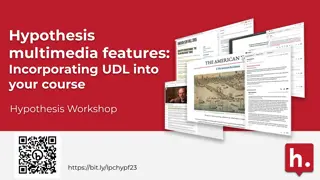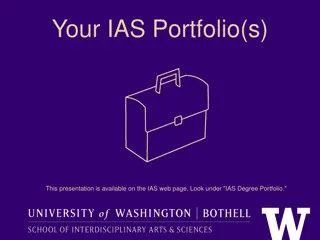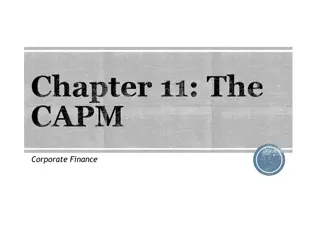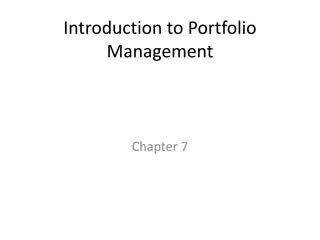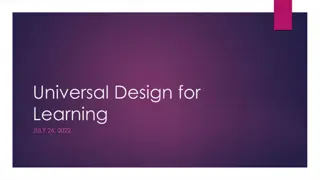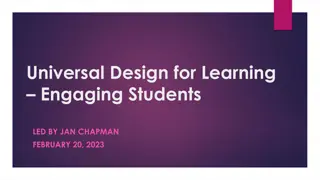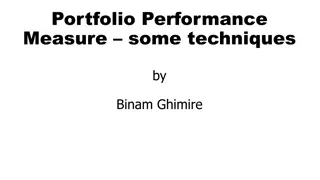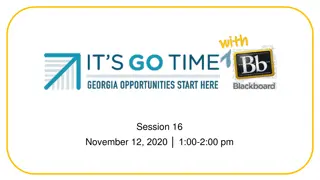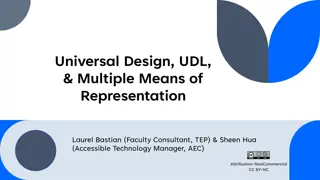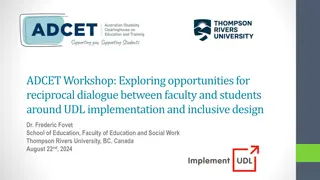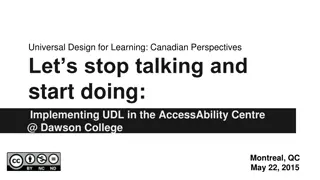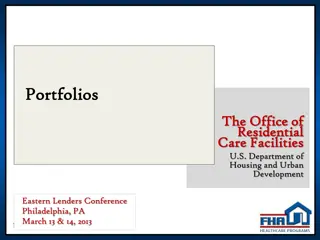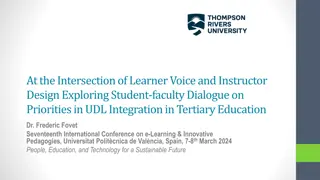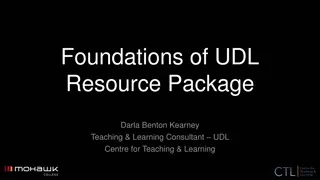
Enhancing Critical Thinking and Learning Portfolio in Humanities
Explore how Alexandra Law adapted her Humanities course sequence using Universal Design for Learning (UDL) principles to foster critical thinking skills and expert learning. Discover her journey, challenges faced, and successful adaptations, especially during emergency remote teaching due to the COVID-19 pandemic.
Download Presentation

Please find below an Image/Link to download the presentation.
The content on the website is provided AS IS for your information and personal use only. It may not be sold, licensed, or shared on other websites without obtaining consent from the author. If you encounter any issues during the download, it is possible that the publisher has removed the file from their server.
You are allowed to download the files provided on this website for personal or commercial use, subject to the condition that they are used lawfully. All files are the property of their respective owners.
The content on the website is provided AS IS for your information and personal use only. It may not be sold, licensed, or shared on other websites without obtaining consent from the author.
E N D
Presentation Transcript
Critical Thinking, Expert Learning Portfolio, Alexandra Law UDL Cohort 2020-2021
What brought me to UDL? Initial Motivation Students who are not registered with AccessAbility but require accommodations Evolving Motivation Exploring connections between critical thinking and expert learning in the Humanities
Humanities Course Sequence Knowledge World Views Ethical Issues All three courses build on students critical thinking skills Independent thinking based on evidence I chose to adapt my World Views course using UDL
Organization of Portfolio Examples Issue The problem I wanted to address Change One UDL-inspired adaptation How the change fits the UDL Guidelines (source: CAST, UDL Guidelines Educator Worksheet v. 2 (2011)) Results (so far)
Context: Emergency Remote Teaching The COVID-19 pandemic made emergency remote teaching necessary for much of the first UDL adaptation semester. Even with classes now in person, the learning experience is not just like before . Several of the changes I made as part of emergency remote teaching overlap with the UDL guidelines, and will become a stable part of my future courses.
Example 1 An Early Change to In-Class Quizzes (Pre-Lockdown)
Example 1- An Early Change to Quizzes ISSUE I have traditionally assigned timed quizzes to test students knowledge of the basic facts that they would later include in essays in my course. These quizzes were almost always closed-book question sheets, completed individually in class. One of my first questions to the UDL group was how to ensure that students would do two things during these quizzes
Example 1 Quizzes, continued Second, support answers using evidence from the reading I often received quizzes from students who would give a vague answer without supporting it with any specific examples from the text. This would happen even if I reminded students to do so verbally beforehand. First, remember relevant facts when students required accommodations related to memory (At this time, I was still thinking mainly in terms of individual accommodations, rather than the overall design of my course. I am grateful for conversations with my current UDL CoP, and also to my colleague and fellow UDL CoP member Ian Cuthbertson for reminding me of this important distinction in an email exchange earlier this year.)
Example 1 Quizzes, continued CHANGE Suggested sentence beginnings on the Quiz The Cohort group gave me helpful feedback on my problem with the quizzes. I adjusted my approach based on their suggestions, offering possible beginnings for each answer. This would help support memory of the facts, while also indicating where specific evidence was required.
Example 1 Quizzes, continued My new quiz included the following question: What is the connection between the story of the traffic accident and one function of law? Explain with details from the reading by Roderick Macdonald. On one side of the quiz paper, the list of questions appeared without reminders, but on the other side were the questions, plus suggestions such as the following
What is the connection between the story of the traffic accident and one function of law? Explain with details from the reading by Roderick Macdonald. Suggested sentence beginnings (try to complete them all for a detailed answer): a) The chapter discusses an accident that happens when... b) One person who sees the accident thinks... c) Another person who sees the accident thinks... d) They think about the accident differently because... e) For Macdonald, this shows that one important function of law is...
Example 1 Quizzes, continued GUIDELINES: Options for Comprehension; Autonomy This change provided additional means of representation according to the Guidelines, by offering a new option for comprehension of the quiz questions (3.3). On a small scale, the suggested sentence beginnings provide a model for the student s answer. Since these are optional, students can use or ignore them as they see fit. This respects students autonomy as they complete the work (7.1 and 7.2).
Example 1 Quizzes, continued RESULTS Not all students chose to use the reminders, preferring to use the questions alone. However, I noticed an increase in the amount of detail in the answers I received. It took extra time to prepare suggested sentence beginnings which would not reveal too much about the text.
Example 2 New Extension Policy
Example 2 New Extension Policy ISSUE Students experienced stress during the emergency remote teaching phase. They had to complete multiple courses online for the first time. Some students also had to care for children or other family members while learning in lockdown. To adapt to this, I tried to design for flexibility (within the constraints imposed by the Academic Calendar).
Example 2 New Extension Policy CHANGE I changed my late assignment policy to offer students an automatic extension of up to one week, no questions asked. The one requirement was that the student had to send me a message with the extension request and the date they planned to submit the work.
Example 2 (Course Outline Excerpt) LATE POLICY: I accept late work without extension with a penalty of 5% per weekday. You can ask for an extension before the deadline, via MIO. Extensions of up to one week are automatically granted upon request, with no documentation required and no penalty.
Example 2 New Extension Policy GUIDELINES: Options for Self-Regulation and Encouraging Autonomy 7.1 and 9.1 The extension policy is a useful option for self-regulation. Students are asked to reflect on how much time they think is reasonable to take before handing in the work based on their individual schedules and workloads. Discussing the extension policy openly, and often, reminds everyone that they are not bad students for making a reasonable request for more time.
Example 2 New Extension Policy RESULTS Many, many students used it, and a few commented on how helpful it was to have some flexibility around deadlines. The policy maintains student accountability for time management because they have to communicate with me before the extension is granted. In this way, I think the policy encourages students to have a sense of personal responsibility for their work.
Example 3 Anxiety, notetaking, and missed classes
Example 3 Anxiety, Notetaking ISSUE Students were not always able to be present for synchronous lectures online, or later, in-person classes. This contributed to their stress at an already difficult time. Students also didn t always feel comfortable interjecting during a live lecture to ask me to repeat myself.
Example 3 Anxiety, Notetaking CHANGES Record classes (lecture) for listening later. I began recording the parts of the class where I spoke for an extended period of time. I stopped recording when students were speaking or doing activities. The practice of videorecording like this in university classes is discussed in UD in HigherEd, From Principles to Practice (Second Edition) Edited by Sheryl E. Burgstahler (2015) , Universal Design for Learning in Postsecondary Education, Reflections on Principles and Their Applications (Chapter 4), Jenna W. Gravel, Laura A. Edwards, Christopher J. Buttimer, David H. Rose, p.87: This recording of the lecture is much more accessible than the live version for many students. Thank you to Laure Galipeau and Catherine Soleil for help finding this reference.
Example 3 Anxiety, Notetaking CHANGES New assignment Post one week of notes to the Class Forum on Lea for credit. Each student signs up for a specific week or has a week assigned to them if they have no preference. Students who miss a class can consult the Class Forum along with the recording to know what they missed.
Example 3 Anxiety, Notetaking GUIDELINES: MINIMIZE DISTRACTIONS (7.3) Offering an audio recording and sets of class notes gives students flexibility and allows them to go over the material in detail, on-demand, and in a less-distracting environment. This minimizes distractions (7.3), including the anxiety of having to ask me to repeat during the class or find notes for missing classes.
Example 3 Anxiety, Notetaking RESULTS As classes resumed in-person, I have continued to do audio-only recordings of lectures and the Posted Notes assignment. In the current context, it keeps my class safer by removing the incentive to come to class sick. Long-term, it makes the class more inviting to students who, for various reasons, may not be able to attend every class in a semester. Students who have to miss a class can take the initiative and keep up-to-date while away.
INTERLUDE How I made my recordings available
INTERLUDE I recognize that not all teachers are comfortable posting their lectures on the internet, we have no obligation to do so, and this may not be a suitable choice for all teaching contexts. I chose to do this, and here is what I did
INTERLUDE While I wanted to make recordings available to currently-enrolled students, I am also protective of my privacy, and my intellectual property. I also did not want to give students a whole (large and possibly costly) file to download for each class. What to do?
INTERLUDE 1)Record the lecture during the live class, using a digital recorder (I bought a dedicated device for this, which has an integrated usb plug for transferring files to a PC); 2)Change the audio file to a video file format compatible with the Vimeo streaming service (Dawson College gave me access to Adobe Creative Cloud, which includes an encoding software for this); 3)Upload the new video file to my private Vimeo account, where it is password-protected (I pay for the video hosting); 4)Post a link to Lea, along with the password so that students can stream it.
INTERLUDE This of course does not prevent anyone from making their own recording of the streamed audio. However, it reduces data requirements for students, and perhaps slows the unauthorized use of recordings. Each recording is available for 7 days and then is removed. I change passwords periodically.
Example 4 Better Feedback
Example 4 Better Feedback ISSUE How can we encourage students to pay attention to feedback and use it effectively? Part of fostering expert learning involves encouraging students to take feedback and incorporate it into their future work. I wanted a way for students to hear the emotion in my voice when I was commenting on their work rather than the flat tone of a correction here and there, line by line. The role of affect was something Laure and Catherine mentioned during our Cohort meetings, and I agree that it is important.
Example 4 Better Feedback CHANGE Use audio recordings to give more detailed, relevant comments. Make a written transcript of the audio available for students who prefer to have comments in writing. In October 2020, I attended the workshop Imagine the Butterfly: Fostering Confidence Through Feedback by Jeff Gandell (English Department, UDL Fellow 2019), which has influenced my approach.
Example 4 Better Feedback GUIDELINES: Mastery-Oriented Feedback 8.4 In addition to fostering a sense of connection with individual students regarding their work, I think the audio feedback was more detailed than written comments. This fits in with the goal of offering mastery-oriented feedback.
Example 4 Better Feedback RESULTS I plan to continue with the audio feedback. A few students remarked to me that they could easily listen to the feedback on their phones, and I have the impression that the students pay more attention to the recorded feedback than to written comments on their papers. At the same time, I have used the Transcribe function in MS Word 365 to offer a transcript of the comments to any students who prefer written feedback.
Example 5 Assignments and Formats
Example 5 Assignments and Formats ISSUE In my assignments, I revisited the initial in-class quiz issue, asking how to encourage students to give detailed, evidence-based responses to major assignment questions. I also wanted to find alternatives to the traditional essay format, to see if different formats would result in more detailed and thoughtful answers.
Example 5 Assignments and Formats CHANGES I added a new assignment, a Critical Thinking Worksheet, which required a diagram illustrating connections between sources, plus an explanatory paragraph. The goal was to have students practice making connections between general statements and specific examples. I added an audio format option for an existing Reading Response assignment. Students can now submit this work in written or audio form.
Example 5 Assignments and Formats GUIDELINES: Multiple Means of Expression; Autonomy; Identify Patterns and Relationships The new assignment relates to a number of the Guidelines, including the offering of multiple means of expression, as well as allowing students to use multiple media to express ideas (2.5; 5). The essence of the assignment is to identify patterns and relationships between main ideas (3.2). The audio option allows for multiple means of expression, and encourages students to use multiple media to express ideas (2.5; 5). The choice of reading and therefore main topic also encourages student autonomy (7.1).
Example 5 Assignments and Formats RESULTS I was surprised by how many students chose the written option for this assignment. I would have thought that the audio review would have been a nice break from essay- writing for more students. At the same time, I think this makes sense from a practical perspective. Students may wish to stay with what they already know, even if other options are available. This makes me think of one of the potential limitations for the implementation of UDL: the anxiety that unfamiliar formats may provoke in students.
Conclusion A work in progress, my World Views class now is based around 4 main assignments, plus the Posted Notes: Critical Thinking Worksheet (diagram plus paragraph) Reading Reflection (written or audio) Independent Response (written work) Summative Assignment (diagram plus paragraph)
Conclusion The Summative is now a chance to revisit the initial format, with its emphasis on making connections, using a new set of texts. The written-only Independent Reflection is meant to prepare students for essay-writing in later courses, and to ensure that each student satisfies Departmental minimum writing requirements for all Humanities courses. Assignments are based on a more flexible schedule, with more relevant and detailed feedback for early work in the semester. Students who miss class or could use an extra set of notes can refer to the Class Forum and the recordings depending on what works for them.



